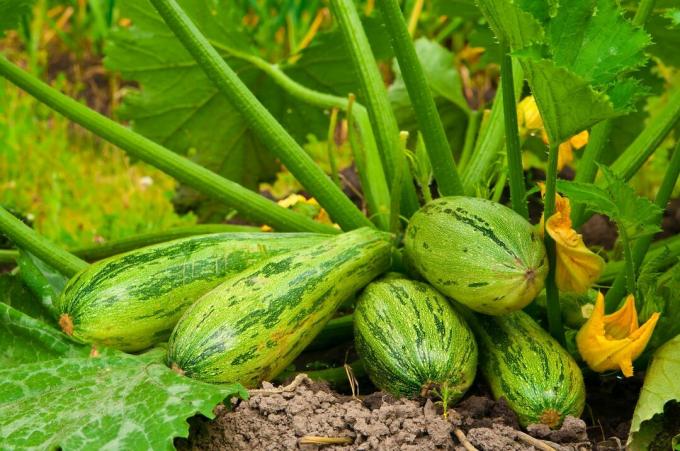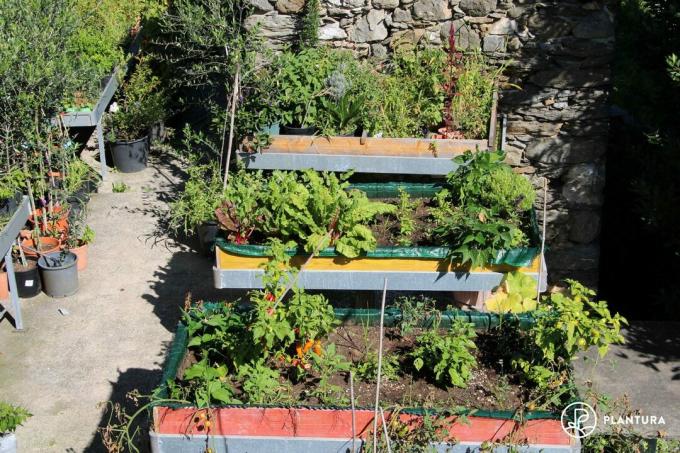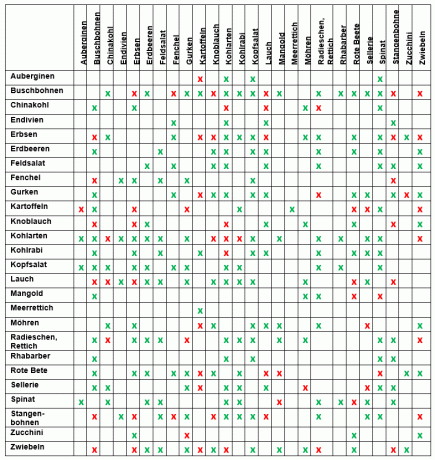Whether strawberries, potatoes or lettuce: a raised bed can be equipped with many plants. Here are tips on how best to plant your raised bed.

contents
- Planting a raised bed: What to look out for in general
- Planting raised bed: planting plan according to heavy, medium and weak consumers
- Planting raised beds: mixed, pre- and post-culture
- Planting a raised bed: step by step to the planting plan
- Plant raised beds in winter: green manure or winter vegetables
Planting a raised bed: What to look out for in general
In principle, the location of a raised bed must be taken into account. After all, most raised beds are not mobile, so the planting must be adapted to the conditions of the raised bed location. It is also particularly important not to plant the raised bed too densely. It is often underestimated how large and lush the initially tiny seedlings or seedlings can become. For example a single one zucchini- or pumpkin plant
likes to take up almost a square meter of space on a nutrient-rich raised bed. But you should also allow this space, after all, numerous fruits can often be harvested from a zucchini or pumpkin plant. However, if the plants are too close together, they compete very fiercely for light, water and nutrients, thereby hindering each other's growth. Planting that is too dense also often means that the plants are poorly ventilated and are prone to fungal infestation.
Ideal vegetables for the raised bed are therefore those that produce a large harvest with just a few plants, be it zucchini or cucumber, which produce fruit all summer or pick-lettuces and herbs from which leaves can be continuously harvested. Even chard and rhubarb are among those grateful plants that keep producing new crops over a very long period of time. plants like bush beans or corn have a relatively high space requirement with a long harvest-free period and are therefore not suitable for a raised bed. Equally impractical are very high-growing vegetables such as tomatoes or pole beans. On the other hand, it makes sense to small stature Tomatoes in the raised bed to grow In deeper beds up to approx. 40 cm high, however, taller growing vegetables or berry bushes can be planted.
A summary of tips for planting raised beds:
- Location requirements of the planting must match the raised bed location
- Do not plant too densely and prefer vegetables with a high yield per plant
- Only plant high-growing vegetables in deeper raised beds
- Divide up available space cleverly

Planting raised bed: planting plan according to heavy, medium and weak consumers
In the Filling the raised bed Using the right material is important. If you take care, a freshly filled raised bed offers a huge nutrient reservoir. The top layers are good soil and compost and the organic matter inside the raised bed slowly decomposes and becomes available to the plants as well. Therefore, in the first two years, the raised bed should preferably be planted with so-called "heavy feeders", i.e. plants that have a high need for nutrients. Those types of vegetables that have a certain but not too great “hunger” for nutrients are referred to as “medium eaters”. They are mainly planted in the second year together with some heavy feeders and in the third year.

If the raised bed is already less nutrient-rich and has perhaps already lowered itself a bit, then the time has come for the “weak eaters”. They provide good crop yields even when there is a shortage of nutrients. This typical flow is important to avoid nutrient leaching and health hazards Nitrate storage in lettuce or spinach when grown in soil that is too nitrogen-rich impede. If only weak feeders are planted in the first or second year, it may be that some of the valuable ones are planted Nutrients are not absorbed by the plants and are washed out into the groundwater with rainwater or irrigation water will. After three to four years, the raised bed has usually lowered quite a bit and can be filled with matured manure or compost. Then the game starts again: first strong, then medium and then weak consumers.
Nutrient requirements - list of cultures:
- „heavy feeder“ (1./2. year): all cabbages apart from Kohlrabi, cucumber, potato, pumpkin, leek, celery, zucchini
- „medium eater“ (2./3. year): endive, fennel, Kohlrabi, chard, carrot, radicchio, radish, Beetroot, sugarloaf, strawberry
- „weak feeder“ (3./4. Year): Bean, pea, garlic, radish, salads (lettuce, iceberg, lettuce, Lamb's lettuce), spinach, onion, Herbs
Planting raised beds: mixed, pre- and post-culture
mixed culture
The mixed culture aims to combine the different plants with their different requirements in such a way that space, nutrients and root space are optimally used. Ideally, this combination will also yield the largest possible harvest. The principle is to plant plants with deep taproots next to plants with shallow root systems so that the plant neighbors do not have to compete for nutrients and water. Tall plants next to narrower ones make ideal use of the space in the bed. In addition, many plants, especially strong-smelling herbs, emit scents that repel various pests. The strong basil scent keeps pests from joining tasty tomato plants. More on the ideal Crop rotation and pest-repellent plants in raised beds you can read in this article.

The principle of first planting heavy, then medium and lastly light-consuming plants is also part of the theme of mixed cultivation. From the many different factors of the mixed culture, conclusions can be drawn about good or bad neighborliness of plants. The following table tells you which plants go well together and which do not get along so well with each other:
green cross: These species promote each other
Red Cross: These species do not get along
no cross: No interspecies effects; can be grown next to each other without any problems

pre and post culture
plants like fennel or Chinese cabbage, which are only sown or planted late, offer the opportunity to plant a fast-growing, early-maturing, so-called pre-culture on their "place". On the other hand, you can look for early-growing vegetables that are, for example, already in July or early August are harvested, well again fast-growing, so-called "post-cultures" are sown or planted will. Salads are suitable both as a pre-culture and as a post-culture, spinach and radish (early varieties) very good. The terms pre- and post-culture can also be used in relation to the previous year's crop and the crop that followed. In this case, it is particularly important to ensure that plants from different plant families and with different nutrient requirements follow one another. For example, it is not advisable strawberries after potatoes to plant, since both crops have a high demand for potassium.

Planting a raised bed: step by step to the planting plan
Planting a raised bed: planting plan – examples of mixed cultures

Alternatively: If the mixed culture planning is too complex and if at best several beds are available, the can only grow one type of vegetable per plot each year, and then a new type of vegetable each year choose. In this way, one only has to consider the nutrient requirements (heavy, medium, light) of the plant and the plant families.

- For the first planting of the raised bed, select some desired heavy-duty types of vegetables.
- Check whether the location requirements (shade, sun, sheltered from the wind, etc.) of the selected species match the location of the raised bed.
- Check the mixed culture table to see whether the planned species get along with each other and, if necessary, choose other vegetables.
Especially when gardening in narrow raised beds, where roots come into direct contact with each other, no plants should be planted next to each other that slow down each other's growth. - Not when planting for the first time, but otherwise very important: Check whether the planned planting is not enough is from the same "sensitive" plant family as last year's crop or the year before last and select possibly. plants from other families.
Especially with cabbages, it is important not to plant them in the same location for as long as possible and, in the case of very small gardens, to take a break from cultivation for a few years after planting. You can find out more about reproduction diseases and how to prevent cultivation problems in raised beds here. - Combine early and late maturing plants
While the early-ripening culture grows quickly and needs a lot of space, it is not yet harassed by the late-ripening plant. If the late-ripening plant starts to need more space, the early-ripening vegetables are at best already ripe and can be harvested. An example would be radishes next to lettuce. As soon as the lettuce reaches a certain size, the radishes are harvested.

Plant raised beds in winter: green manure or winter vegetables
When the raised bed or any other vegetable patch is harvested in the fall, most home gardeners think the work for the gardening year is done. But if the bed lies fallow all winter, you can use the Rainfall in late autumn or winter washes out many nutrients and carries them into the groundwater will. This is a pity and can be avoided in a relatively simple way with winter planting. Classic winter salads such as endive, frisee and Lamb's lettuce or spinach can be sown or planted in autumn and provide fresh vitamins in winter. More about the edible Winter planting in the raised bed can be found here.
If you don't like that or if you want to give the bed special fertility, you should opt for a green manure decide. Plants that are not harvested are referred to as green manure. As they grow, they store the nutrients in the soil, and as they rot, they slowly become available again in the spring for new planting in the raised bed. In addition, catch crops loosen the soil with their roots and sometimes even enrich it with nitrogen (legumes). Those plants that are not hardy like oil radish or buckwheat, naturally die and decompose in winter. Hardy green manure plants such as sainfoin or clover must be turned over in February, but remain on the bed. Green manure plants often also have a very pleasant weed suppressing effect. If sown early enough, they can even flower and thus provide an important food source for bees in the fall.
However, when choosing green manure, you should not lose sight of the plant families. For example, the popular green manure crops mustard and radish belong to the cruciferous family and should therefore not be sown in beds where cabbage plants are planned in the future. If you already have a complicated planting plan and have difficulties in arranging plant families, we recommend Phacelia as green manure. Their plant family does not belong to any known vegetable species, which is why there can be no negative influences. The cover crop is often sown quite late and therefore does not reach its full size. However, if it is sown early in the summer, care should be taken not to select a high-growing culture such as buckwheat for the raised bed.

Tips on location and crop rotation summarized:
- Legumes such as these are particularly suitable for low-nitrogen soils broad bean, lupine, vetch and clover, as these enrich the soil with nitrogen. In the following year neither peas nor beans should be planted.
- For low-nitrogen loamy soil, flat pea, Crimson Clover and lupine are excellent soil conditioners.
- If you do not grow cabbage for reasons of taste, the cruciferous radish and mustard are ideal as green manure. They grow very quickly, making them ideal for suppressing weeds, and their mustard oils are effective against harmful nematode species.
- Yellow lupine is recommended for acidic soil.
- In the case of complicated crop rotation (cabbages and legumes), it is best to choose phacelia (bee friend) as green manure.
In the case of late clearing vegetables (e.g pumpkin) it may be that there is no time left to sow green manure. Then the raised bed can be covered with leaves or grass clippings. Fruit tree foliage is best suited for this. Oak leaves, on the other hand, should only be used in limited quantities because of their growth-inhibiting tannins. The soil cover promotes soil life and contributes to the formation of humus.
Advantages of winter planting summarized:
- Prevention of nutrient leaching
- soil loosening
- nutrient enrichment
- weed suppression
- fresh vitamins (salads, spinach)
tip: If you want to help out with an organic fertilizer in addition to a green manure, you can use our for vegetables in the raised bed Plantura organic tomato fertilizer excellent use. This has a three-month long-term effect and ensures active and healthy soil life in the raised bed.
weiYou can find more inspiration on the subject of “raised beds” here on our Pinterest page:
